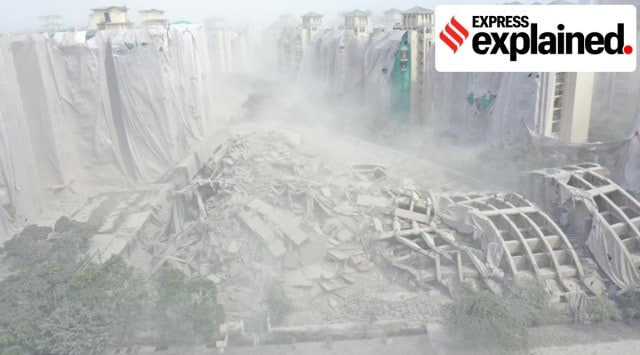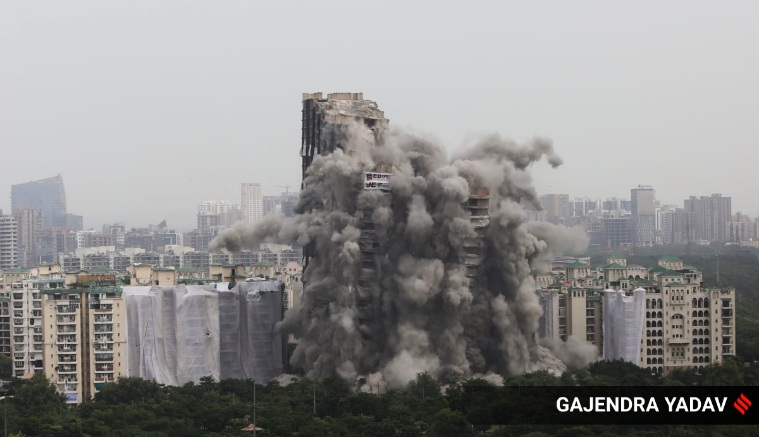Explained: Noida Supertech twin towers gone, what happens to the debris that is left?
What remains after the demolition of the Noida Supertech twin towers is a mountain of concrete rubble that will now have to be disposed of quickly, safely, and efficiently. What is the nature of the task and how will it be accomplished?
 The rubble that is now left at the site is essentially large slabs of concrete and pieces of steel. (Express photo)
The rubble that is now left at the site is essentially large slabs of concrete and pieces of steel. (Express photo)The Supertech twin towers are literally done and dusted, and what remains at the site where they stood in Noida’s Sector 93A is a mountain of concrete rubble that will now have to be disposed of quickly, safely, and efficiently. What is the nature of the task and how will it be accomplished?
How much rubble are we talking about?
In terms of weight, about 80,000 tonnes, according to Utkarsh Mehta, partner at Edifice Engineering, which was the contractor for the demolition. A tonne is 1,000 kilograms. In terms of volume, about 36,000 cubic metres of debris was expected to be generated, according to a debris management plan that Edifice submitted to Noida Authority on August 24.
The taller tower, Apex, was 102 metres high and had 32 stories. The shorter, Ceyane, was 95 metres and 29 stories tall. For reference, the Qutub Minar is 73 metres high, and India Gate is 42 metres. The two towers together had 915 flats, but all walls and brickwork had been removed before the demolition, leaving only the concrete shell.
The rubble that is now left at the site is essentially large slabs of concrete and pieces of steel.
What will be done with this small mountain of debris?
The twin towers had two large basements. According to Edifice’s debris management plan, the bulk of the debris — 23,133 cubic metres out of the total 36,000 cubic metres — will be used to fill the basement. In terms of weight, that will account for around 50,000 tonnes of the total 80,000 tonnes. A small portion of this debris will also be used for some essential construction at the site.
 Work to remove debris has been handed over to Ramky Group, with three months to complete the job. (Express photo by Gajendra Yadav)
Work to remove debris has been handed over to Ramky Group, with three months to complete the job. (Express photo by Gajendra Yadav)
The remaining 30,000-odd tonnes — 12,867 cubic metres according to the debris management plan — will have to be removed from the site. Whatever material can be re-used will be separated and employed for this purpose. Noida Authority CEO Ritu Maheshwari has said that the rest of the debris will be processed at a construction and demolition waste management plant in a scientific manner.
Who will manage the cleaning-up operation, and how long will it take?
This task has been given to the Hyderabad-based Ramky Group, which specialises in large civil and environmental infrastructure development and waste management projects. The job is supposed to be completed in 90 days in coordination with government authorities and the Residents’ Welfare Association (RWA).
What had happened in the 2020 Maradu demolition case?
In January 2020, four apartment complexes built in Maradu, Kochi were demolished on the orders of the Supreme Court over violation of Coastal Regulation Zone norms. The rubble left behind was around 76,250 tonnes, apart from 1,000 tonnes of thermo-mechanically treated (TMT) steel bars. Kochi-based Prompt Enterprises, which was given the contract for removing the concrete rubble, took nearly four months to completely clear the demolition site.
The concrete chips from the rubble of Holy Faith H2O and Jain Coral Cove buildings were used to make hollow bricks and pavement tiles. The rubble from the other two sites was used for land-filling and related purposes.
The re-use of concrete debris from demolition sites is a common practice in Western countries, and is catching on in India, industry experts said.
- 01
- 02
- 03
- 04
- 05






































